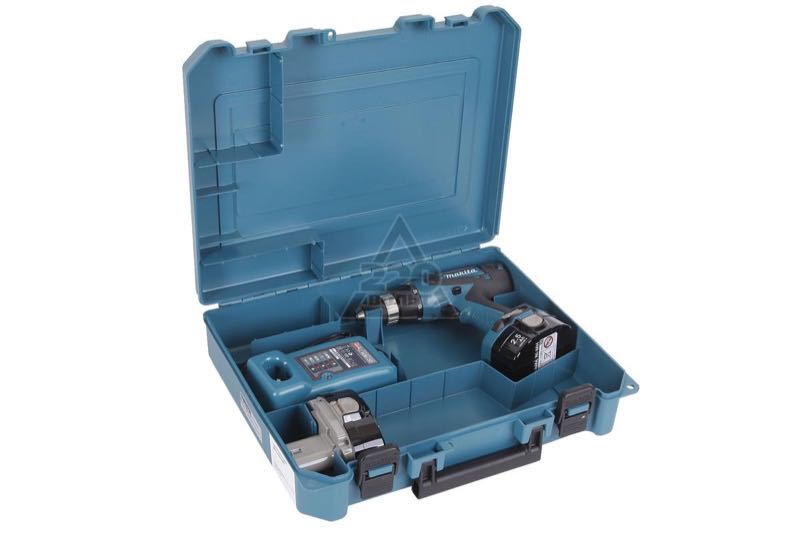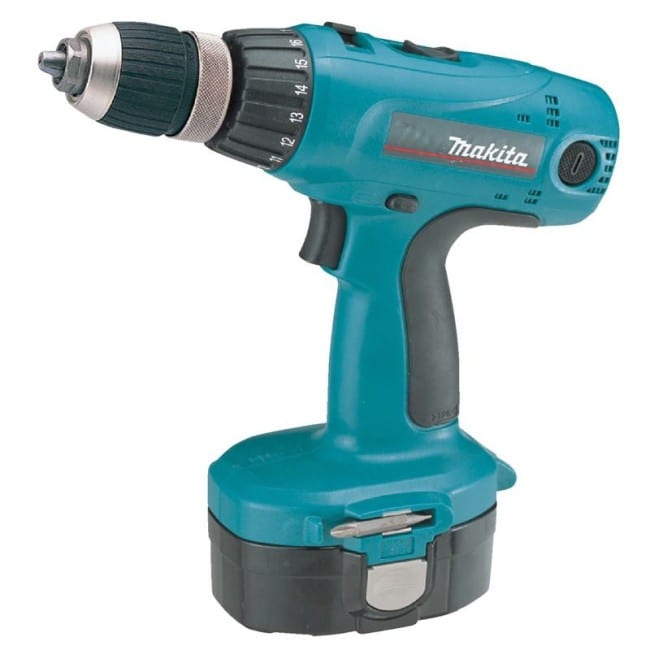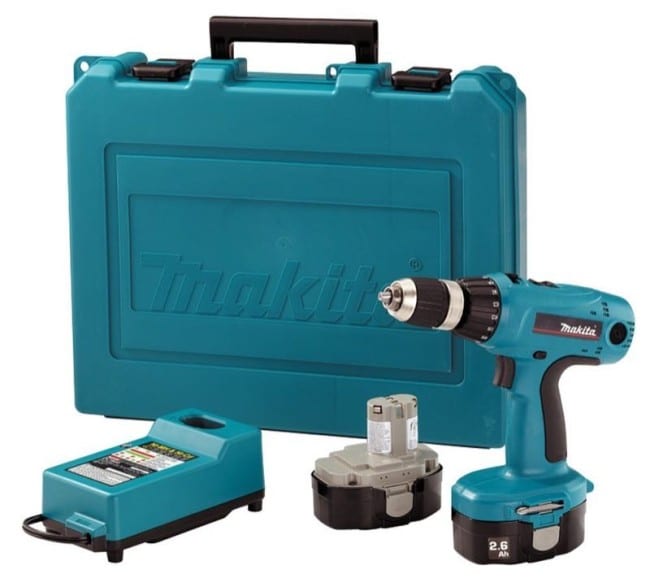We took the Makita 6347DWDE cordless drill to task and set about building a children’s play set—complete with slide, 4 swings, and a covered fort. The work involved lots of fasteners and even some seriously tough hot dipped galvanized lag and hex bolts. We quickly discovered that Makita has some serious power and stamina in this 18V tool. After all, you can’t take just any old wimpy cordless drill and expect to sink a 4-inch galvanized lag bolt through two pieces of pressure treated lumber!
Editor’s Note: Check out the new Makita XPH07M 18V LXT Brushless 1/2″ Hammer Drill
Makita 6347DWDE Cordless Drill Build Quality
The Makita 6347DWDE cordless drill kit comes with the Makita drill, multi-voltage charger and rugged plastic case (with a continuous metal-reinforced rear hinge). The rather roomy case has ample storage for the included charger and batteries, and additional space for bits and other small accessories as well. The drill has a rubberized rear grip that makes it easy to hold even in the worst of scenarios and the forward and reverse controls are of the expected double-sided push variety. The chuck is a Jacobs 500 series – a popular choice among cordless drivers we’ve seen, though there are many flavors and textures in this series. This one has a non-rubberized plastic adjustment ring that feels a lot like metal and seemed very durable. It was very easy to load and unload bits using a quick burst of the drill in reverse at low speed.
The torque control is among our favorites of all the models we’ve tested to-date, and Makita has adopted the PTI torque method for measuring its tools. It has a nice ratcheting feel and can be rotated from the bottom with your left hand. The torque adjustment collar goes from 0-16 and there is no “drill mode” on the collar itself. Instead, Makita opts for a proprietary “Shift Lock” switch that locks out the clutch and switches the 6347DWDE from driver to drill mode.
On the rear of the cordless drill, Makita has provided user accessible access to replace the carbon brushes. We’re seeing this more and more and it’s a nice feature that ensures that you’re going to have many years of use with this product provided you don’t go swimming with it.
The Ni-MH batteries were a favorite of mine – at least until lithium ion came along, but Makita has to be given kudos for being one of the first to pioneer this technology and say goodbye to NiCd technology. Ni-MH essentially meant that you wouldn’t have to buy new batteries every year – something that is very common with NiCd-based systems. The batteries load and unload easily, with side buttons that don’t take 1000 newtons of pressure to depress. The included charger will work with both NiCd and Ni-MH batteries fro Makita and handle anything from 7.2-18V.
Ergonomics and Use
The first thing you’ll note about the Makita 6347DWDE cordless drill is that it’s perfectly balanced. While not the lightest drill we’ve encountered, the Makita doesn’t tip forward or backwards in your hand even when loosely held with your fingers splayed open; the drill simply pushes straight down. We found that when working overhead or in a situation that demanded awkward extensions of the arm, this resulted in the best possible ergonomics. The drill simply feels right.
The forward and reverse controls are easily accessed with a simple thumb or forefinger movement. When the two-way switch is left in the middle, the trigger is locked and the drill will not activate. The speed control switch is located at the top of the drill and it’s actually quite difficult (unnecessarily so) to switch from low speed to high (and vice versa). The Shift Lock switch was easy enough to use, though a red release button meant that you had to come in from the front to activate it in one fluid motion. After some practice this got much easier. SPeaking of speed, the Makita feels “slower” than many other drills we’ve used, and as a result it doesn’t feel like it has the same amount of toque and drivability as some other competing brands.
Adjusting the torque setting via the adjustable collar was almost a pleasure. This is one area that Makita has nailed – at least in terms of adjustment. The collar delivers a satisfying click on each number and the length of the drill body gave ample room to adjust the collar from underneath. As newer drills/drivers reduce the size and weight of the top of the body, adjustments to the torque collar tend to be more easily accomplished from the top, forcing you to tilt the tool upside down or sideways before making adjustments on the fly.
Battery life on this drill is average and we found it to run a long time before needing a recharge. Makita’s newer Lithium-ion products will improve this considerably, but note that the new batteries will NOT fit existing drills. Makita redesigned the Lithium ion line to have a different balance.
We felt that the trigger of the 6347DWDE was about perfect. It engaged readily and there seemed to be just the right amount of play and resistance to dial in the speed you would want in any particular application. When starting self-tapping screws, for example, it was easy to begin the process slowly and then ramp up to maximum speed. Even in the high speed mode we were able to start at a low enough speed to easily set most screws.
In the Field
We used the Makita 6347DWDE to build an entire children’s play set from scratch. This entailed drilling and driving dozens and dozens of screws and more than a few bolts though large pieces of pressure treated lumber and decking material. Throughout the entire project we went through only two batteries, which was amazing considering the project took most of the afternoon. We found that driving screws into PT was easily accomplished, but the Makita seemed more about control than speed. As a result, we were able to more quickly sink screws with competitive brands moreso than with the 6347DWDE. The NiMH batteries also seemed to have very little drop-off after the first several screws that meant that maximum speed and torque was unaffected over time. The drill was still a powerhouse, but the particular speed and torque settings Makita chose may put this drill at a slight disadvantage over the 18V competition.
In our specific speed tests, we used a laser photo tachometer to measure the rotational speed in both low (1) and high (2) speeds. To do this we took three measurements with a battery that was used for 10 minutes and another set of measurements with a fresh battery. With the 10-minute battery we got the following results (no load):
| Lowest Reading | Highest Reading | Drill Speed |
|---|---|---|
| 328.0 | 331.1 | Low |
| 329.1 | 335.0 | Low |
| 330.1 | 332.6 | Low |
| 1093 | 1109 | High |
| 1095 | 1104 | High |
| 1098 | 1103 | High |
These numbers were a little low with respect to the factory numbers (0-400/0-1300), so we wanted to see if they would get up to the expected speeds after a new battery was installed. After swapping out for a fresh battery we got the following (we only did high speed measurements):
| Lowest Reading | Highest Reading | Drill Speed |
|---|---|---|
| 1102 | 1111 | High |
| 1095 | 1102 | High |
| 1092 | 1096 | High |
The numbers were still low – almost identical to the initial measurements, in fact. This showed us that at least the battery has a very consistent performance across the life of its charge – a good trait to exhibit as it means you won’t be finding yourself with less speed and torque as the job goes on. Where the extra 70 RPM (low speed) and 200 RPM (high speed) went we have no idea, but we’re not sure of the testing conditions Makita uses in-house. In either case, the speed isn’t nearly as important in and of itself as the real-world performance tests done under torque.
Conclusion
The 6347DWDE provided ample horsepower and its easy to use and ergonomic torque control means that contractors and handymen will both appreciate the ease of use this tool offers. User-accessible brush replacement and Ni-MH batteries also indicate a tool that will last for years and years – even under extreme stress. Competition is fierce, however, and other brands seem to provide a bit more torque and maximum speed over this particular Makita.






Have one of these … a great battery operated drill.